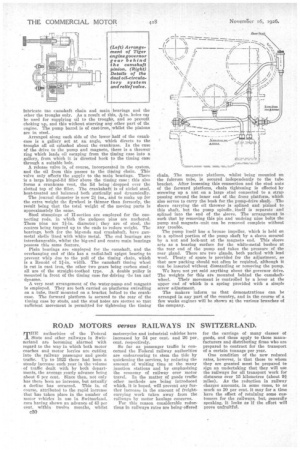ROAD MOTORS versus RAILWAYS IN SWITZERLAND.
Page 52

If you've noticed an error in this article please click here to report it so we can fix it.
T11 authorities of the Federal State and other railways in Switzerland are becoming alarmed with regard to the way in which both motor coaches and motor lorries are cutting into the railway passenger and goods traffic. Up to 1025 there had been a steady increase each year in the volume
• of traffic dealt with by both departments, the average yearly advance being about 6 per cent. Since then, not only has there been no increase, but actually a decline has oeeurred. This is, of course, attributed to the rapid increase • that has taken place in the number of motor vehicles in use in Switzerland, ears having shown an advance of 43 per cent. within twelve months, whilst c30 motorcycles and industrial vehicles have increased by 54 per cent. and 26 per cent. respectively.
So far as passenger traffic is concerned the Federal railway authorities are endeavouring to stem the tide by quickening the services, by reducing the amount of waiting time at the many junction stations and by emphasizing the economy of railway over motor travel. In the matter of goads traffic other methods are being introduced which, it is hoped, will prevent any further increase in the amount of freightcarrying work taken away from the railways by motor haulage concerns.
For this reason considerable reductions in railways rates are being-offered for the carriage of many classes of goods, and these apply to those manufacturers and distributing firms who are prepared to contract for the transport of a certain tonnage per year.
One condition of the new reduced rates, however, is that those to whom they are granted must be prepared to sign an undertaking that they will use the railways for all transport work for distances over 15 kilometres (about 9a miles). As the reduction in railway charges amounts, in some eases, to as much as 20 per cent, it may for a time have the effect of retaining some customers for the railways, but, generally speaking, it looks as if the effort will prove unfruitful.












































































































